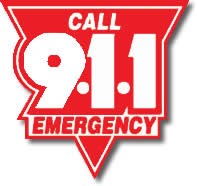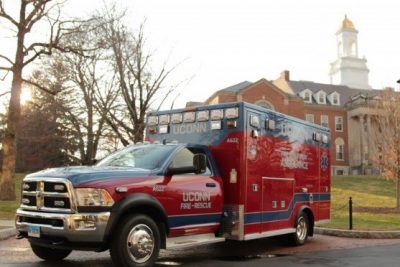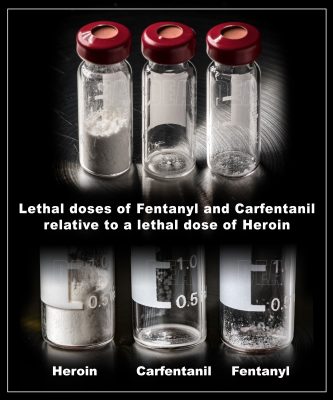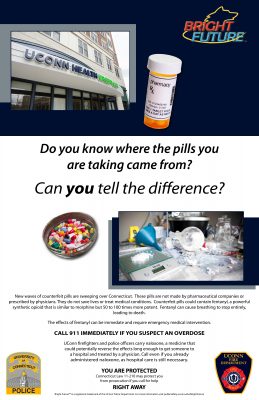- Open Office Hours with Police Command Staff
- Police Community Challenge
- Coffee With A Cop
- Community Outreach Unit
- Education and Crime Prevention Programs & Events
- Self-Defense Classes
- Bright Future
- Experiential Education – Internships and Practicum Experiences
- Crime Prevention and Awareness
- Community Outreach Programs Catalog
- Citizens Police Academy

WORKING HAND IN HAND FOR A BRIGHT FUTURE
Bright FutureTM
A Bright Future™ is what the UConn Police Department wants for you and for everyone in our community. The men and women of the UCPD work hand-in-hand with members of our community to identify University Safety concerns, provide education, host community events, and realize practical and effective solutions to the issues facing our neighborhoods. These efforts, coupled with directed enforcement and thorough investigations, serve to make Bright Future™ a model University Safety campaign by the UConn Police Department. Through using a multifaceted approach to complex problems, we provide education, information, and enforcement as we work cooperatively with community members to achieve safer communities and a Bright Future™ for everyone.
Collaboration
A safe community is only possible with the combined efforts of local law enforcement and the communities they serve. UConn Police officers constantly work with members of the UConn community to identify University Safety concerns. They then become part of the collaborative solutions to ensure safe communities.
Education
Members of the UConn Police Department bring to the community leading edge education through facilitated learning activities and public information efforts. Interactive presentations on sexual violence prevention, alcohol and other drug awareness, interpersonal communication skills and more are all key components to a Bright FutureTM for the community. Officers continually assess programming through detailed data collection and develop information for the community that will resonate with a broad spectrum of community members. The UConn Police Department also utilizes partner information packages for community groups that want to be leaders in making a Bright Future for our entire campus.
Directed Enforcement
Whether it be increasing dedicated patrols to address specific issues such as underage drinking, impaired driving, or other public health risks; implementing leading-edge training for our officers investigating crimes of sexual violence; or enhancing the delivery of services to victims and witnesses of crime in our neighborhoods, all members of the UConn Police Department strive for excellence in our law enforcement efforts.
Opioid Awareness
“In Connecticut, residents are more likely to die from unintentional drug overdose than a motor vehicle accident. Majority of these deaths are linked to overdose of prescription opioid painkillers. According to 2013 CDC report, the Connecticut age-adjusted rate for drug induced mortality is 16.4 per 100,000 population compared to the nation rate of 14.6.” – Connecticut State Department of Public Health
According to the National Institute on Drug Abuse, Opioids are a class of drugs that include the illegal drug heroin, synthetic opioids such as fentanyl, and pain relievers available legally by prescription, such as oxycodone, hydrocodone, codeine, morphine, and many others.
All opioids are chemically related and interact with opioid receptors on nerve cells in the body and brain. Opioid pain relievers are generally safe when taken for a short time and as prescribed by a doctor, but because they produce euphoria in addition to pain relief, they can be misused (taken in a different way or in a larger quantity than prescribed, or taken without a doctor’s prescription). Regular use—even as prescribed by a doctor—can lead to dependence and, when misused, opioid pain relievers can lead to addiction, overdose incidents, and deaths.”
Regardless of whether or not the opioid was prescribed or illicit, a person is having a potential medical emergency if you see the signs of an opioid overdose. Call 911 right away.
Signs of an Opioid Overdose
An opioid overdose is life-threatening and requires immediate emergency intervention. If you can recognize the signs of an opioid overdose and call 911 right away, you can save a life. Call 911 immediately if a person exhibits any one of these symptoms:
- Heartbeat or respirations are slowed… or stopped.
- Unconsciousness/ non-responsiveness
- Pinpoint pupils
- Limp body
- Clammy skin
- Fingernails or lips have a purple or blue color.
- Vomiting or making gurgling noises.
- Presence of opioid paraphernalia (pill bottles, needles, etc.)
Respiratory depression leads to hypoxia, or inadequate blood oxygenation, which can cause permanent brain damage or death. Opioid overdose can slow the heart rate which can also be fatal.
A person exhibiting any of these signs is at risk of a life-threatening medical emergency and could die if they don’t get help right away.
Our Families, Friends, and Neighbors at Risk
According to the World Health Organization people dependent upon opioids are the group most likely to suffer an overdose but people at higher risk of opioid overdose are:
- people with opioid dependence, in particular following reduced tolerance (following detoxification, release from incarceration, cessation of treatment);
- people who inject opioids;
- people who use prescription opioids, in particular those taking higher doses;
- people who use opioids in combination with other sedating substances;
- people who use opioids and have medical conditions such as HIV, liver or lung disease or suffer from depression;
- household members of people in possession of opioids (including prescription opioids).
Save a Life
You can save a person who is experiencing an opioid overdose. 
- Call 911 immediately
- Support the person’s breathing
- Administer naloxone if you have it
- Lay the person on their side if they resume breathing
- Stay with the person until the firefighters, EMTs, or officers arrive.
Naloxone, sometimes known by the brand name Narcan, is a medication that rapidly reverses the effects of opioid overdose and can potentially allow enough time for emergency responders to get the person to medical treatment by a physician.
 UConn firefighters, EMT’s, and police officers all carry naloxone and are trained in its emergency use. If you call us right away, we can help you save a life. Even if you have and administer naloxone yourself, you still need to call 911 right away. The amount of naloxone they received may not outlast the opioid effects and they can slip back into an overdose. Even with naloxone, they need to see a doctor.
UConn firefighters, EMT’s, and police officers all carry naloxone and are trained in its emergency use. If you call us right away, we can help you save a life. Even if you have and administer naloxone yourself, you still need to call 911 right away. The amount of naloxone they received may not outlast the opioid effects and they can slip back into an overdose. Even with naloxone, they need to see a doctor.
You are Protected
Connecticut passed a “good Samaritan” law in 2011 under Public Act 11-210. This law protects people from criminal prosecution who, in good faith, call 911 for a person who they reasonably believe is experiencing an overdose from the ingestion, inhalation, or injection of intoxicating liquor or any drug or substance.
Don’t hesitate to call 911. Our firefighters, EMT’s, and police officers want to help a person who is suffering an overdose. We can get them to advanced medical care.
You may be protected if you:
- Call 911 without hesitation
- Do not take time to hide anything you think is illegal, honesty is key to “good faith”
- Stay to help the person in need and wait until we arrive
- Show responders any medications or drugs they took so they can relay that to doctors
- Truly try to help Save a Life.
For more information on opiate pain medications, overdose, and addiction warning signs, visit the Connecticut Poison Control Center through UConn Health.
Below are our UConn Residential Partner Package resources:
| Bright Future Opioid Poster 1- Final.jpg |
| Bright Future Opioid Poster 2- Recognizing the Signs of an Opioid Overdose.jpg |
| BrightFutureLogo(B).jpg |
For our Alcohol Awareness and Safety Partner Package, check below.
Illicit and Counterfeit Pills
Fentanyl and Carfentanil – Do you know where your pills came from?
Do you know where the pills you are taking come from? Unless you received a prescription from a physician and got it filled by a pharmacist, you likely have no idea what’s really in that pill you’re about to take. Can you tell an authentic Xanax from a counterfeit?
Fentanyl was introduced in medical practice in the 1950s as an intravenous anesthetic. Today, various fentanyl derivatives are used in both anesthetics and for chronic pain management. Illicit use of pharmaceutical fentanyls first appeared in the mid-1970s and continues to be a problem in the United States. Over the years, the distribution of illicitly manufactured fentanyl and synthetics have been sweeping over the globe. It isn’t just cut and sold as heroin. It is also illegally pressed into pill form and sold as something else. It also has specific interactions with drugs such as Xanax that are fatal.
Novel synthetic opioids (NSOs) include various analogs of fentanyl and newly emerging fentanyl compounds. Together with illicitly manufactured fentanyl, these drugs have caused a recent spike in overdose deaths. Studies cited by the U.S. National Institutes of Health show that the recent rise in synthetic opioid overdose deaths is largely due to illicitly manufactured fentanyl.
 Fentanyl is 30-50 times more potent than heroin and 50-100 times more potent than morphine.
Fentanyl is 30-50 times more potent than heroin and 50-100 times more potent than morphine.
Law enforcement agencies and public health officials are also seeing an alarming trend of the drug carfentanil also being distributed mixed in with heroin and cocaine. Carfentanil is an analogue of fentanyl with an analgesic potency 10,000 times that of morphine and 100 times that of fentanyl. It was developed for veterinary practices to immobilize certain large animals like elephants. There is no valid and approved medical use for carfentanil in humans. You can barely see the quantity of carfentanil that will be a lethal dose for a human. It can kill you just through contact with the skin.
For more information on fentanyl, visit the Drug Enforcement Administration’s Drug Facts sheet.
Alcohol Awareness – Know Your Limits
Some college students feel a lot of pressure to consume alcohol and other drugs. According to the National Institute of Health’s National Institute on Alcohol Abuse and Alcoholism, about half of all college students who drink, also consume alcohol through binge drinking. This can lead to serious health concerns, injury or death; increased criminal abuse and victimization; academic problems; and increased risk to one’s mental health.
Through the Bright FutureTM Alcohol and Other Drug Awareness campaign, our officers focus their efforts in educating the community on the dangers of alcohol and other drugs as well as empowering our community to make Simple Decisions to ensure a brighter future. Our educational efforts include:
- interactive classroom experiences
- facilitated activity events designed to let participants experience certain risks in a safe environment
- targeted enforcement of impaired driving, underage drinking, service of alcohol to minors, and drug use
- comprehensive public information efforts including print and other media
- partner packages
We are committed to putting forth our best efforts in community education and the enforcement of the laws to ensure a community safe from those who would endanger others.
If you would like to learn more about the Bright FutureTM Alcohol or Other Drug Safety Campaign, schedule an educational event or program, or become a Community Partner in our efforts, please contact the Community Outreach Unit of the UConn Police Department at PDStartTeam@uconn.edu or call 860-486-2375 for more information.
Below are our UConn Residential Partner Package resources:
